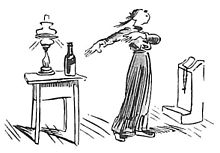The pious Helene

The pious Helene is a picture story by the satirical draftsman and poet Wilhelm Busch . The story was published in 1872 by Bassermann Verlag , which was headed by Wilhelm Busch's long-time friend Otto Friedrich Bassermann . Similar to Busch's picture story St. Anthony of Padua, the story is shaped by Busch's anti-clerical stance. Against the background of the Kulturkampf in Germany, the picture story quickly found a large readership. It is still one of Wilhelm Busch's most popular stories today.
Content and background
In the pious Helene , Wilhelm Busch illuminates satirical religious hypocrisy and shady civic morality:
“A good person likes to
pay attention whether the other does something bad too;
And strives for
his improvement and conversion through frequent instruction "
Many details of the pious Helene are shaped by Busch's biographical experience. In 1867 he met the Frankfurt banker's wife Johanna Keßler through his brother Otto Busch. A friendship of several years developed between the two, but according to the assessment of the overwhelming number of Busch biographers it remained platonic. The mother of seven was an influential art and music patron in Frankfurt and believed she would discover a painter who had not yet been adequately appreciated in Busch. In this assessment she was supported by Anton Burger , a leading member of the Kronberg painters' colony . Johanna Keßler furnished Wilhelm Busch's apartment and studio in her spacious villa on Bockenheimer Landstrasse . Motivated by their support and admiration, Wilhelm Busch devoted himself primarily to painting in his Frankfurt years, spent a lot of time at the Städel and was very productive as a painter. Johanna Keßler, however, was critical of his humorous work. The pious Helene came into being in the late phase of Busch's Frankfurt years and shows elements of increasing alienation and critical analysis of the Kessler family's concept of life.
Johanna Keßler was married to a significantly older man and had her children raised by governesses and tutors while she played an active role in Frankfurt social life.
"I want to be silent about the theater.
How from there, late in the evening,
beautiful mother, old father
goes home arm in arm"
“Although you have a lot of children,
you think nothing of it.
And the children become sinners
If the parents don't care. "
The marriage of the clearly aged Helene to the rich GIC Schmöck also seems to be a parallel to Johanna Keßler's husband, who abbreviated his name to JDH Keßler . In the opinion of the Busch biographer Weissweiler , Schmöck is derived from Schmock , a Yiddish swear word that means stupid , idiot or idiot . Johanna Keßler will have understood this allusion, because her husband was completely uninterested in art and culture.
In the second part of the pious Helene , Wilhelm Busch attacks the Catholic pilgrimage . The pious Helene appeared at the time of the Kulturkampf and Wilhelm Busch had already found a large anti-Catholic readership in Saint Anthony of Padua . However, it can be assumed that Wilhelm Busch did not specifically exploit anti-Catholic tendencies in order to find a broad readership. Wilhelm Busch, raised as a Protestant, doubted the Catholic saints from the outset because of his pessimistic image of man. In a satirical way he exaggerates an attitude towards life that is alien to him. This too has a biographical background. During his time in Munich, he had visited Andechs Monastery together with Munich artist colleagues and was amused to see how many pilgrim couples retreated to the bushes in the vicinity of the monastery.
Accompanied by her cousin Franz, the so far childless Helene goes on a pilgrimage. The pilgrimage shows success; after a due time, Helene gives birth to twins, whose similarity to her father makes it clear to the reader that the father is not Schmöck, but cousin Franz. Schmöck suffocates in his fresh fatherly joy at the feast that he has to heart, and cousin Franz also comes to an early end, since he is not only interested in Helene but also in the kitchen staff and is therefore struck by the jealous valet Jean. The now widowed Helene is left with only rosary, prayer book and alcohol as a consolation of life. She ends when she falls drunk into a burning kerosene lamp; her soul is then kidnapped by the devil himself into hell, where she has to keep Franz, who has already arrived, company.
After Helen's tragicomic ending, the philistine Nolte formulates a moral sentence that is often interpreted as a fitting summary of Schopenhauerian wisdom:
"The good - this sentence is clear -
is always what is bad, what you leave!"
filming
The pious Helene was filmed in 1965 by Axel von Ambesser under the same title . Simone Rethel played the title role .
Web link
expenditure
- Wilhelm Busch: The pious Helene . 10th edition, Diogenes, Zurich 2007, ISBN 978-3-257-20109-3 (in cooperation with Wilhelm-Busch-Gesellschaft Hannover).
literature
- Michaela Diers: Wilhelm Busch, life and work. dtv, Munich 2008, ISBN 978-3-423-34452-4 .
- Joseph Kraus: Wilhelm Busch. Rowohlt, Reinbek near Hamburg 1970; 16th edition 2004, ISBN 3-499-50163-5 .
- Gudrun Schury: I wish I were an Eskimo. The life of Wilhelm Busch. Biography . Structure, Berlin 2007, ISBN 978-3-351-02653-0 .
- Gert Ueding : Wilhelm Busch. The 19th century in miniature ; Insel, Frankfurt am Main 1977; New edition 2007, ISBN 978-3-458-17381-6 .
- Eva Weissweiler: Wilhelm Busch. The laughing pessimist. A biography . Kiepenheuer & Witsch, Cologne 2007, ISBN 978-3-462-03930-6 .


